<dependency>
<groupId>com.mulesoft.connectors</groupId>
<artifactId>mule-microsoft-service-bus-connector</artifactId>
<version>x.x.x</version>
<classifier>mule-plugin</classifier>
</dependency>xmlMicrosoft Service Bus Connector 2.2
Anypoint Connector for Microsoft Service Bus (Microsoft Service Bus Connector) enables message integration with Windows Service Bus on-premises. The connector supports communication with queues and topics through Advanced Message Queuing Protocol (AMQP) 1.0. In addition, dynamic discovery and provisioning of Service Bus objects is possible using the built-in management API.
To implement message integration scenarios with Microsoft Azure, use the Microsoft Azure Service Bus Connector instead of this connector.
Release Notes: Microsoft Service Bus Connector Release Notes
Exchange: Microsoft Service Bus Connector
|
This connector supports connecting only to the Microsoft Windows Service Bus on-premises solution. To connect to Microsoft Azure Service Bus, use Anypoint Connector for Azure Service Bus |
Before You Begin
To use this connector, you should be familiar with Microsoft Service Bus, Mule runtime engine (Mule), Anypoint Connectors, Anypoint Studio, Mule concepts, elements in a Mule flow, and Global Elements.
You need one of the following credential types to test your connection to your target resource:
-
Windows credentials type
-
SAS (shared access signature) - Deprecated
-
Username and password - Deprecated
For software requirements and compatibility information, see the Connector Release Notes.
To use this connector with Apache Maven, click the Dependency Snippets link in Anypoint Exchange.
The connector supports the Microsoft Windows Service Bus on-premises.
POM File Information
Verify that the connector version corresponds to the one you are using.
To obtain the most up-to-date pom.xml file information:
-
Go to Anypoint Exchange
.
-
In Exchange, click Login and supply your Anypoint Platform username and password.
-
In Exchange, search for
SAP S/4HANA OData. -
Click Dependency Snippets.
Add the Connector in Studio
-
In Studio, create a Mule project.
-
In the Mule Palette view, click (X) Search in Exchange.
-
In Add Modules to Project, type
service busin the search field. -
Click this connector’s name in Available modules.
-
Click Add.
-
Click Finish.
Configure in Studio
-
Drag a connector’s operation to the Studio Canvas.
-
Configure the Global element for the connector.
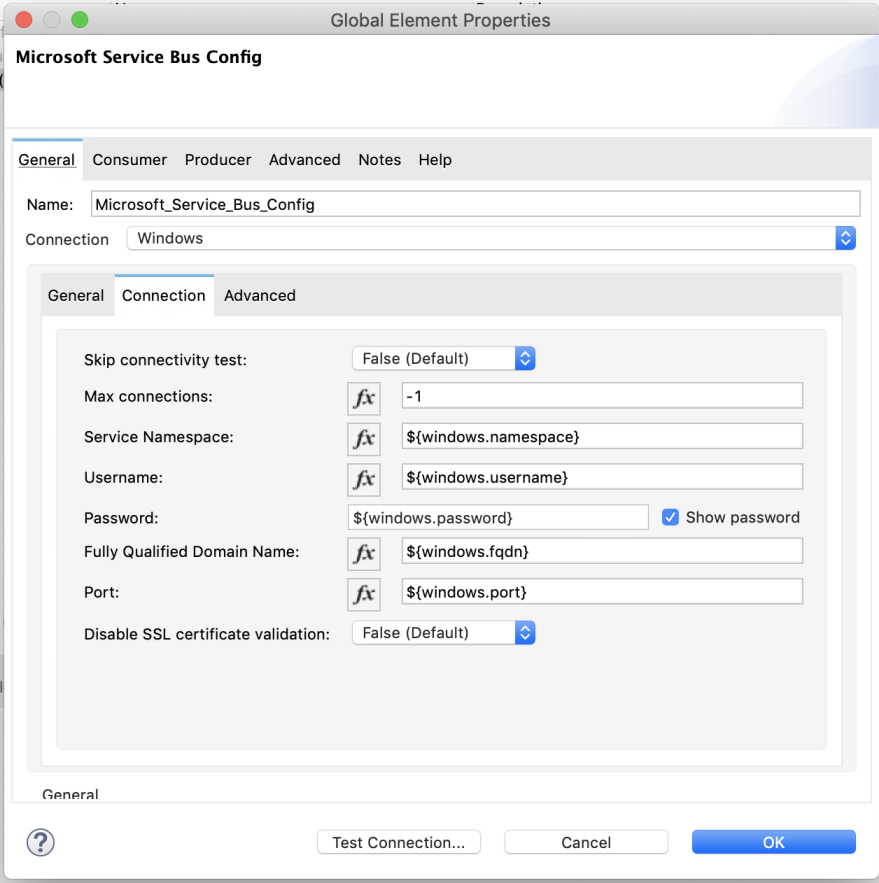
Get Queue List Use Case
This use case retrieves a list of existing queues in a specific namespace. It returns the list in JSON format.
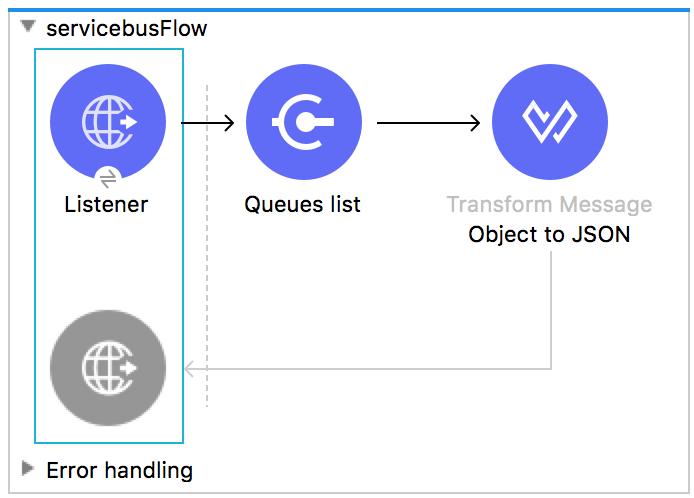
-
Create a new Mule application in Studio and select HTTP > Listener as a source in the new flow.
-
Add a new HTTP Listener configuration global element:
-
Specify the Host and Port parameters with the following values:
Parameter Value Host
0.0.0.0
Port
8081
-
Click Save.
-
Assign the new global configuration to HTTP Listener.
-
Complete the HTTP Listener path with the value
/servicebus. -
Drag a new Service Bus component operation into the flow.
-
Configure the Service Bus connector global element with its environment values.
-
Add a transform message before the connector and add an output like this:
%dw 2.0 output application/json --- payloaddataweave -
Save and run the project as a Mule application.
To test the app, navigate to
http://127.0.0.1:8081/servicebus.
XML flow:
<?xml version="1.0" encoding="UTF-8"?>
<mule xmlns:ee="http://www.mulesoft.org/schema/mule/ee/core"
xmlns:servicebus="http://www.mulesoft.org/schema/mule/servicebus"
xmlns:http="http://www.mulesoft.org/schema/mule/http"
xmlns="http://www.mulesoft.org/schema/mule/core"
xmlns:doc="http://www.mulesoft.org/schema/mule/documentation"
xmlns:xsi="http://www.w3.org/2001/XMLSchema-instance"
xsi:schemaLocation="http://www.mulesoft.org/schema/mule/core
http://www.mulesoft.org/schema/mule/core/current/mule.xsd
http://www.mulesoft.org/schema/mule/http
http://www.mulesoft.org/schema/mule/http/current/mule-http.xsd
http://www.mulesoft.org/schema/mule/servicebus
http://www.mulesoft.org/schema/mule/servicebus/current/mule-servicebus.xsd
http://www.mulesoft.org/schema/mule/ee/core
http://www.mulesoft.org/schema/mule/ee/core/current/mule-ee.xsd">
<configuration-properties file="mule-app.properties" />
<http:listener-config name="HTTP_Listener_config" doc:name="HTTP Listener config" >
<http:listener-connection host="0.0.0.0" port="8081" />
</http:listener-config>
<servicebus:config name="Servicebus_Config" doc:name="Servicebus Config" >
<servicebus:windows-connection
namespace="${config.namespace}"
username="${config.username}"
password="${config.password}"
fqdn="${config.fqdn}" />
</servicebus:config>
<flow name="servicebusFlow">
<http:listener doc:name="Listener" config-ref="HTTP_Listener_config"
path="/servicebus"/>
<servicebus:queues-list doc:name="Queues list" config-ref="Servicebus_Config"/>
<ee:transform doc:name="Object to JSON">
<ee:message >
<ee:set-payload ><![CDATA[%dw 2.0
output application/json
---
payload]]></ee:set-payload>
</ee:message>
</ee:transform>
</flow>
</mule>xmlSSL Issues
If you get one of the following errors when performing a connectivity test or starting a Mule app, you must configure the truststore in insecure mode:
-
SSL certificate error -
General SSLEngine problem
To configure the truststore in insecure mode:
-
Navigate to the Security tab in the global element configuration.
-
In the Security field, select Edit inline.
-
In the Trust Store Configuration section, select the Insecure checkbox.
-
Click OK.
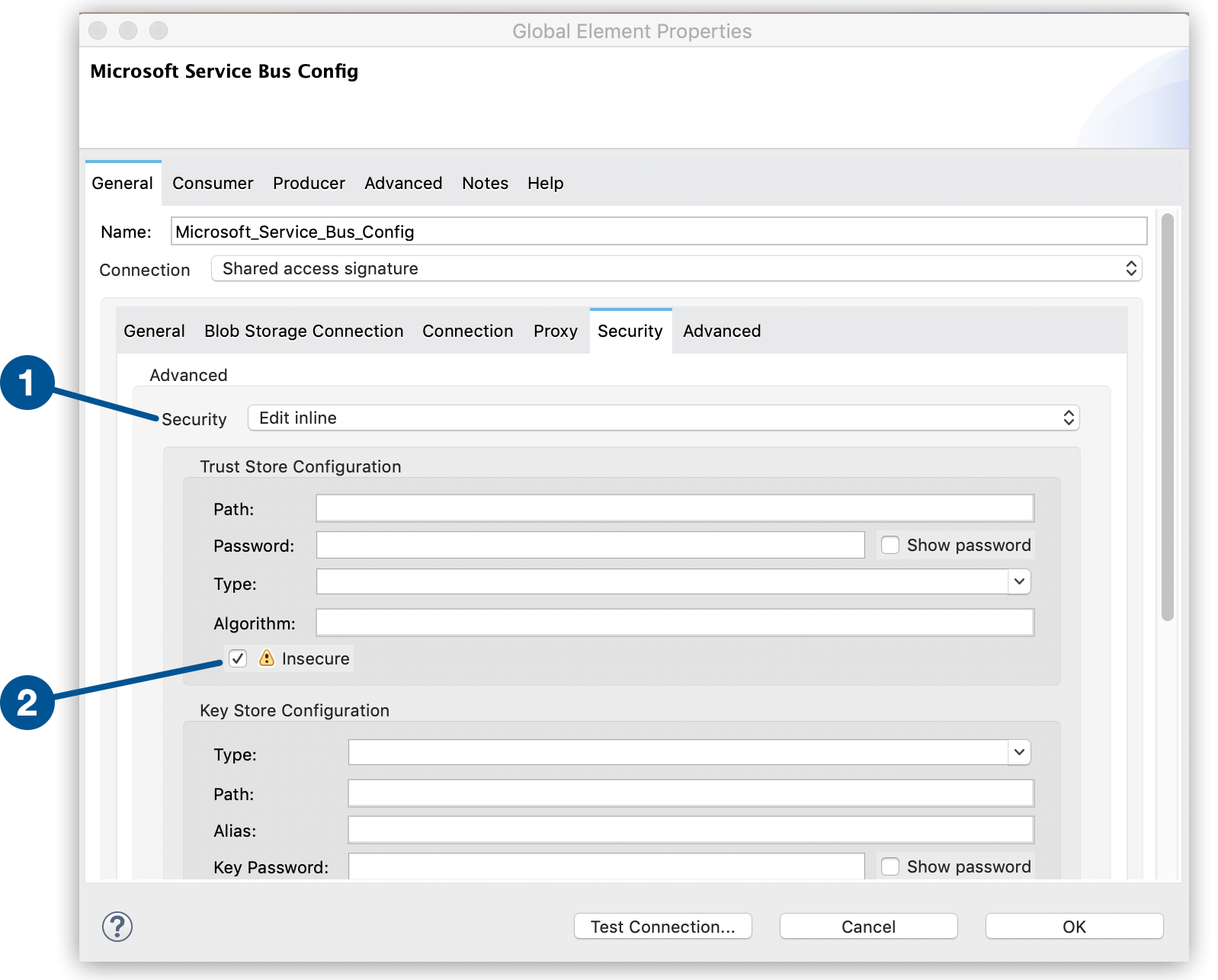
The first item shows where to select Edit inline and the second item shows where to select the Insecure checkbox.
For more information, see Failed Connectivity Test.
Service Bus Authentication
For sending and receiving messages through Microsoft Service Bus Connector, the authentication is performed through AMQP.
For the REST Management API, the authentication scheme differs based on the Microsoft Service Bus version. Windows Service Bus uses OAuth.
| Windows Service Bus uses a self-signed SSL certificate to secure the communication using AMQP and HTTPS. The connector won’t run if this certificate is not locally imported in the box running Mule, unless the Ignore SSL warning check is enabled. |
To enable the SSL checks, follow these steps to import the certificate:
-
Use the PowerShell cmdlet Get-SBAutoGeneratedCA
to download the certificate locally in the machine running the Windows Service Bus.
For this example, the certificate file is exported to%temp%\AutoGeneratedCA.cer. -
Running as Administrator, go to
%programfiles%\Java\jre7.
You must be running as Administrator to perform a certificate import withKeytool.exe. -
Verify that the
bin\keytool.exetool andlib\security\cacertsexists. -
Enter the following command:
bin\keytool.exe –list –keystore lib\security\cacerts -
Import the autogenerated Service Bus certificate by running the following command: +
bin\keytool.exe –importcert –alias AppServerGeneratedSBCA –file %temp%\AutoGeneratedCA.cer –keystore lib\security\cacerts –v -
Enter the password when prompted (the default is “changeit”).
-
When the tool asks you whether to trust the certificate, enter
Y(Yes).
Using Restricted Access Policies
If you have restricted access to your resources, such as having a security policy with permissions at the resource level, the connector cannot perform the connectivity test when it starts. This occurs because the connectivity test targets the root level of your namespace, which might be forbidden due to the customized policy applied to the shared access key. For these scenarios, skip the connectivity test with the configuration option available for this purpose, otherwise, the connector fails to start.
Log Requests and Responses
To log requests and responses when using the connector, configure a logger by adding this line to the Loggers element of the log4j2.xml configuration file for the Mule app:
<AsyncLogger name="org.springframework.web.client"
level="DEBUG"/>xmlThe following example shows the Loggers element with the AsyncLogger line added:
<?xml version="1.0" encoding="UTF-8"?>
<Configuration status="WARN">
<Appenders>
<Console name="Console" target="SYSTEM_OUT">
<PatternLayout pattern="%d{HH:mm:ss.SSS} [%t] %-5level %logger{36} - %msg%n"/>
</Console>
</Appenders>
<Loggers>
<AsyncLogger name="org.springframework.web.client" level="DEBUG" additivity="false">
<appender-ref ref="Console" level="debug"/>
</AsyncLogger>
</Loggers>
</Configuration>xmlYou can view the app log as follows:
-
If you’re running the app from the Anypoint Platform, the output is visible in the Anypoint Studio console window.
-
If you’re running the app using Mule from the command line, the app log is visible in your OS console.
Unless the log file path was customized in the app’s log file (log4j2.xml), you can also view the app log in this default location:
MULE_HOME/logs/<app-name>.log
For more information about the app log, see Configuring Logging.
Windows Service Bus AMQP Use Case
This use case contains the following flows that send and receive messages for topics and queues:
-
load-http-form-flowProvides a web form for entering the parameters for messages.
-
topic-endpoint-flowReceives messages through the
load-http-form-flow, stores each message as the payload, converts each message to a Java object, and sends each message to the destination topic. -
queue-endpoint-flowReceives messages through the
load-http-form-flow, stores each message as the payload, converts each message to a Java object, and sends each message to the destination queue. -
queue-receive-flowListens for, receives, and logs messages from the specified queue.
-
topic-receive-flowListens for, receives, and logs messages from the specified topic.
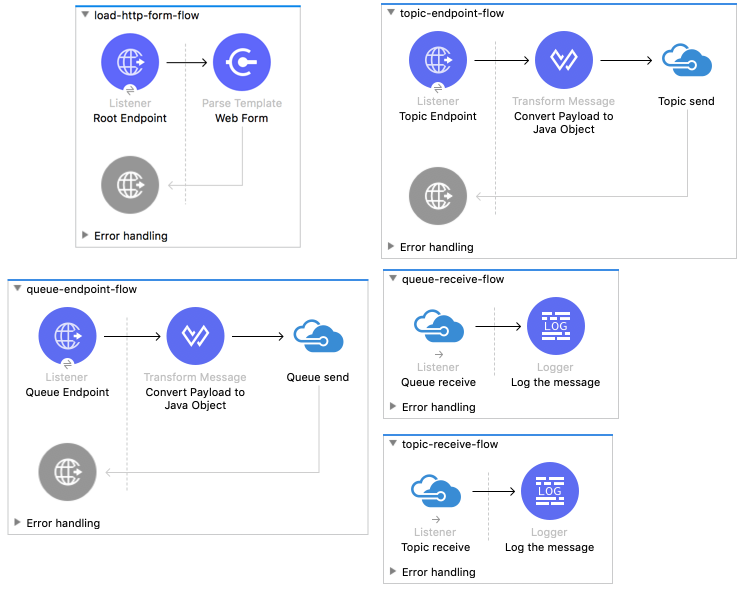
XML for this flow:
<?xml version="1.0" encoding="UTF-8"?>
<mule xmlns:ee="http://www.mulesoft.org/schema/mule/ee/core"
xmlns:servicebus="http://www.mulesoft.org/schema/mule/servicebus"
xmlns:http="http://www.mulesoft.org/schema/mule/http"
xmlns="http://www.mulesoft.org/schema/mule/core"
xmlns:doc="http://www.mulesoft.org/schema/mule/documentation"
xmlns:xsi="http://www.w3.org/2001/XMLSchema-instance"
xsi:schemaLocation="http://www.mulesoft.org/schema/mule/core
http://www.mulesoft.org/schema/mule/core/current/mule.xsd
http://www.mulesoft.org/schema/mule/http
http://www.mulesoft.org/schema/mule/http/current/mule-http.xsd
http://www.mulesoft.org/schema/mule/servicebus
http://www.mulesoft.org/schema/mule/servicebus/current/mule-servicebus.xsd
http://www.mulesoft.org/schema/mule/ee/core
http://www.mulesoft.org/schema/mule/ee/core/current/mule-ee.xsd">
<configuration-properties file="mule-app.properties" doc:name="Configuration properties"/>
<http:listener-config name="HTTP_Listener_config" doc:name="HTTP Listener config">
<http:listener-connection host="0.0.0.0" port="8081" />
</http:listener-config>
<servicebus:config name="Microsoft_Service_Bus_Config" doc:name="Microsoft Service Bus Config">
<servicebus:windows-connection
namespace="${windows.namespace}"
username="${windows.username}"
password="${windows.password}"
fqdn="${windows.fqdn}"
port="${windows.port}"/>
</servicebus:config>
<flow name="load-http-form-flow">
<http:listener doc:name="Root Endpoint" config-ref="HTTP_Listener_config"
path="/" />
<parse-template doc:name="Web Form" location="form.html" />
</flow>
<flow name="queue-endpoint-flow">
<http:listener doc:name="Queue Endpoint" config-ref="HTTP_Listener_config"
path="/pushMessageQueue" />
<ee:transform doc:name="Convert Payload to Java Object">
<ee:message>
<ee:set-payload><![CDATA[%dw 2.0
output application/java
---
payload]]></ee:set-payload>
</ee:message>
</ee:transform>
<servicebus:queue-send doc:name="Queue send" config-ref="Microsoft_Service_Bus_Config"
destinationQueue="#[payload.queue]">
<servicebus:message >
<servicebus:body ><![CDATA[#[payload.message]]]></servicebus:body>
</servicebus:message>
</servicebus:queue-send>
</flow>
<flow name="topic-endpoint-flow">
<http:listener doc:name="Topic Endpoint" config-ref="HTTP_Listener_config"
path="/pushMessageTopic"/>
<ee:transform doc:name="Convert Payload to Java Object">
<ee:message >
<ee:set-payload ><![CDATA[%dw 2.0
output application/java
---
payload]]></ee:set-payload>
</ee:message>
</ee:transform>
<servicebus:topic-send doc:name="Topic send" config-ref="Microsoft_Service_Bus_Config"
destinationTopic="#[payload.topic]"
transactionalAction="NOT_SUPPORTED"
sendCorrelationId="AUTO">
<servicebus:message >
<servicebus:body ><![CDATA[#[payload.message]]]></servicebus:body>
</servicebus:message>
</servicebus:topic-send>
</flow>
<flow name="queue-receive-flow">
<servicebus:listener
sourceType="Queue"
destination="${queue.name}"
doc:name="Queue receive"
config-ref="Microsoft_Service_Bus_Config"
ackMode="AUTO" subscription="NONE"
numberOfConsumers="1"/>
<logger level="INFO" doc:name="Log the message" message="#[payload]"/>
</flow>
<flow name="topic-receive-flow">
<servicebus:listener sourceType="Topic" doc:name="Topic receive"
config-ref="Microsoft_Service_Bus_Config"
ackMode="AUTO" destination="${topic.name}"
subscription="${subscription.name}"/>
<logger level="INFO" doc:name="Log the message" message="#[payload]"/>
</flow>
</mule>xmlWindows Service Bus Management Use Case
This use case contains flows that create topics, subscriptions, and rules:
-
service-bus-management-demoFlowCreates a topic by following these steps:
-
Creates the topic description as specified and stores it as the payload.
-
Creates the topic using the stored configuration from the previous step and the topic namespace, obtained from variable
topic.name. -
Converts the newly created topic to a JSON object.
-
Logs the JSON object.
-
-
service-bus-management-demoFlow1Creates a subscription by following these steps:
-
Creates the subscription description as specified and stores it as the payload.
-
Creates the subscription using the stored configuration from the previous step, the subscription name from the variable
subscription.name, and the topic name from the variabletopic.name. -
Converts the newly created subscription to a JSON object.
-
Logs the JSON object.
-
-
service-bus-management-demoFlow2Creates a rule by following these steps:
-
Creates a rule with the specified configuration and stores it as the payload.
-
Creates the rule using the stored configuration from the previous step, the rule name from the variable
rule.name, the subscription name from the variablesubscription.name, and the topic name from the variabletopic.name. -
Converts the newly created rule to a JSON object.
-
Logs the JSON object.
-
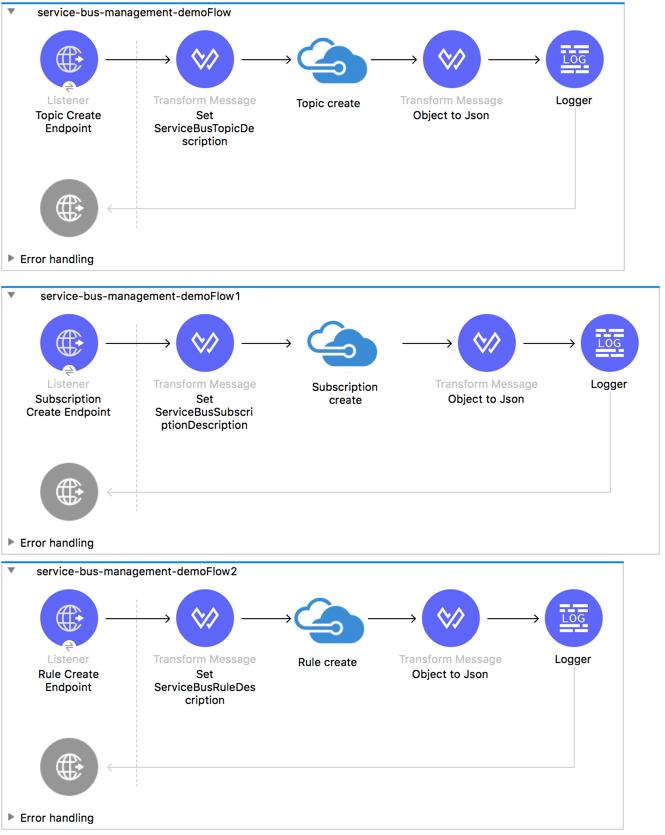
XML flow:
<?xml version="1.0" encoding="UTF-8"?>
<mule xmlns:ee="http://www.mulesoft.org/schema/mule/ee/core"
xmlns:servicebus="http://www.mulesoft.org/schema/mule/servicebus"
xmlns:http="http://www.mulesoft.org/schema/mule/http"
xmlns="http://www.mulesoft.org/schema/mule/core"
xmlns:doc="http://www.mulesoft.org/schema/mule/documentation"
xmlns:xsi="http://www.w3.org/2001/XMLSchema-instance"
xsi:schemaLocation="http://www.mulesoft.org/schema/mule/core
http://www.mulesoft.org/schema/mule/core/current/mule.xsd
http://www.mulesoft.org/schema/mule/http
http://www.mulesoft.org/schema/mule/http/current/mule-http.xsd
http://www.mulesoft.org/schema/mule/servicebus
http://www.mulesoft.org/schema/mule/servicebus/current/mule-servicebus.xsd
http://www.mulesoft.org/schema/mule/ee/core
http://www.mulesoft.org/schema/mule/ee/core/current/mule-ee.xsd">
<configuration-properties file="mule-app.properties"
doc:name="Configuration properties"/>
<http:listener-config name="HTTP_Listener_config"
doc:name="HTTP Listener config">
<http:listener-connection host="0.0.0.0" port="8081" />
</http:listener-config>
<servicebus:config name="Microsoft_Service_Bus_Config" doc:name="Microsoft Service Bus Config">
<servicebus:windows-connection
namespace="${windows.namespace}"
username="${windows.username}"
password="${windows.password}"
fqdn="${windows.fqdn}"
port="${windows.port}"/>
</servicebus:config>
<flow name="service-bus-management-demoFlow">
<http:listener doc:name="Topic Create Endpoint"
config-ref="HTTP_Listener_config"
path="/topic"/>
<ee:transform doc:name="Set ServiceBusTopicDescription">
<ee:message >
<ee:set-payload ><![CDATA[%dw 2.0
output application/java
---
{
defaultMessageTimeToLive: "P10675199DT2H48M5.4775807S",
duplicateDetectionHistoryTimeWindow: "PT10M",
enableBatchedOperations: false,
maxSizeInMegabytes: 1024,
requiresDuplicateDetection: false,
sizeInBytes: null
} as Object {
class : "com.mulesoft.connectors.microsoft.servicebus.extension.api.entity.ServiceBusTopicDescription"
}]]></ee:set-payload>
</ee:message>
</ee:transform>
<servicebus:topic-create doc:name="Topic create"
config-ref="Microsoft_Service_Bus_Config"
topicPath="${topic.name}">
</servicebus:topic-create>
<ee:transform doc:name="Object to Json">
<ee:message >
<ee:set-payload ><![CDATA[%dw 2.0
output application/json
---
{
author: payload.author,
id: payload.id,
title: payload.title
}]]></ee:set-payload>
</ee:message>
</ee:transform>
<logger level="INFO" doc:name="Logger" message="#[payload]"/>
</flow>
<flow name="service-bus-management-demoFlow1">
<http:listener doc:name="Subscription Create Endpoint"
config-ref="HTTP_Listener_config"
path="/subscription"/>
<ee:transform doc:name="Set ServiceBusSubscriptionDescription">
<ee:message >
<ee:set-payload ><![CDATA[%dw 2.0
output application/java
---
{
lockDuration: "PT4M",
requiresSession: false,
deadLetteringOnMessageExpiration: false,
deadLetteringOnFilterEvaluationExceptions: null,
enableBatchedOperations: false,
defaultMessageTimeToLive: "P10675199DT2H48M5.4775807S",
maxDeliveryCount: null
} as Object {
class : "com.mulesoft.connectors.microsoft.servicebus.extension.api.entity.ServiceBusSubscriptionDescription"
}]]></ee:set-payload>
</ee:message>
</ee:transform>
<servicebus:subscription-create
topicPath="${topic.name}"
doc:name="Subscription create"
config-ref="Microsoft_Service_Bus_Config"
subscriptionPath="${subscription.name}"/>
<ee:transform doc:name="Object to Json">
<ee:message >
<ee:set-payload ><![CDATA[%dw 2.0
output application/json
---
{
linik: payload.link,
id: payload.id,
title: payload.title
}]]></ee:set-payload>
</ee:message>
</ee:transform>
<logger level="INFO" doc:name="Logger" message="#[payload]"/>
</flow>
<flow name="service-bus-management-demoFlow2">
<http:listener doc:name="Rule Create Endpoint"
config-ref="HTTP_Listener_config"
path="/rule"/>
<ee:transform doc:name="Set ServiceBusRuleDescription">
<ee:message >
<ee:set-payload ><![CDATA[%dw 2.0
output application/java
---
{
action: {
sqlExpression: "set MyProperty2 = 'ABC'",
"type": "SqlRuleAction"
},
filter: {
correlationId: null,
sqlExpression: "property1 = 'ok'",
"type": "SqlFilter"
}
} as Object {
class : "com.mulesoft.connectors.microsoft.servicebus.extension.api.entity.ServiceBusRuleDescription"
}]]></ee:set-payload>
</ee:message>
</ee:transform>
<servicebus:rule-create topicPath="${topic.name}" doc:name="Rule create"
config-ref="Microsoft_Service_Bus_Config" rulePath="${rule.name}"
subscriptionPath="${subscription.name}"/>
<ee:transform doc:name="Object to Json">
<ee:message >
<ee:set-payload ><![CDATA[%dw 2.0
output application/json
---
{
link: payload.link,
id: payload.id,
title: payload.title
}]]></ee:set-payload>
</ee:message>
</ee:transform>
<logger level="INFO" doc:name="Logger" message="#[payload]"/>
</flow>
</mule>xml


